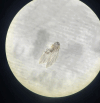Shared Delusional Parasitosis in Two Families: Clinical Insights Into Folie à Deux and Folie à Trois
- PMID: 40773771
- PMCID: PMC12331216
- DOI: 10.2196/78398
Shared Delusional Parasitosis in Two Families: Clinical Insights Into Folie à Deux and Folie à Trois
Abstract
Delusional parasitosis is a rare psychotic disorder characterized by individuals firmly believing that they are infested with parasites despite no medical evidence. It may be shared among close contacts-termed folie à deux when 2 individuals are affected or folie à trois when 3 individuals share the delusion. Delusional parasitosis' somatic focus often leads patients to seek dermatologists, causing delayed diagnoses and unnecessary antiparasitic treatments. Herein, we present 2 familial cases of shared delusional parasitosis. In both cases, patients exhibited the matchbox sign, presenting nonparasitic materials as "evidence" of infestation. Dermatological and psychiatric evaluations excluded organic causes, diagnosing primary delusional parasitosis. Treatment with antipsychotic medications led to symptom remission. Psychoeducation was critical in preventing relapse in secondary cases. Delusional parasitosis with shared delusions is often misdiagnosed, requiring dermatologists to recognize it early. A multidisciplinary approach that combines psychiatric care and psychoeducation is essential for effective management and for preventing the reinforcement of delusional beliefs.
Keywords: delusional parasitosis; folie à deux; matchbox sign; psychodermatology; shared psychotic disorder.
© Gökçe Işıl Kurmuş, Hanife Karataş, Elif Erdem, Süheyla Doğan Bulut, Müzeyyen Gönül, Selda Pelin Kartal. Originally published in JMIR Dermatology (http://derma.jmir.org).
Conflict of interest statement
Figures




Similar articles
-
Aripiprazole Treatment in Delusional Infestation: Resolving Atypical Presentations of Body Fluid Leakage.Am J Case Rep. 2025 Jun 12;26:e948375. doi: 10.12659/AJCR.948375. Am J Case Rep. 2025. PMID: 40504767 Free PMC article.
-
Morgellons Disease as a Delusional Parasitosis: A Case Presenting with Dermatological and Ocular Symptoms.J Psychiatr Pract. 2025 Jul 1;31(4):227-229. doi: 10.1097/PRA.0000000000000872. J Psychiatr Pract. 2025. PMID: 40679805
-
Delusional parasitosis as 'folie a deux'.J Korean Med Sci. 2003 Jun;18(3):462-5. doi: 10.3346/jkms.2003.18.3.462. J Korean Med Sci. 2003. PMID: 12808343 Free PMC article.
-
Delusional Parasitosis: Diagnosis and Treatment.Isr Med Assoc J. 2018 Jul;20(7):456-460. Isr Med Assoc J. 2018. PMID: 30109800 Review.
-
A case series of shared delusional infestation: folie à deux revisited.Clin Exp Dermatol. 2020 Jun;45(4):414-416. doi: 10.1111/ced.14138. Epub 2019 Dec 20. Clin Exp Dermatol. 2020. PMID: 31729765 Review.
References
-
- Mumcuoglu KY, Leibovici V, Reuveni I, Bonne O. Delusional parasitosis: diagnosis and treatment. Isr Med Assoc J. 2018 Jul;20(7):456–460. Medline. - PubMed
Publication types
MeSH terms
Substances
LinkOut - more resources
Full Text Sources

